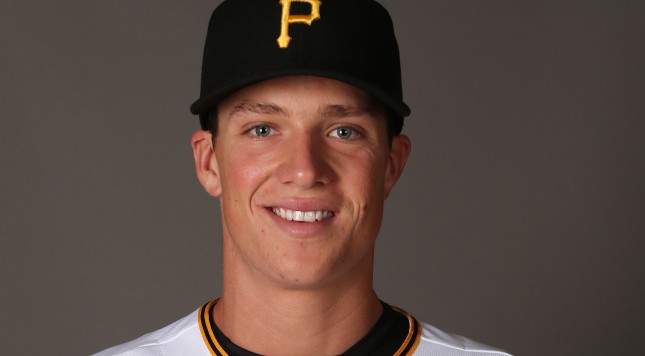It rained all afternoon in Chapel Hill, and as the clocked ticked closer to seven o’ clock, I was sending text messages to my friends.
You know that I don’t care how hard it’s raining, I’m going out to DBAP tonight unless they cancel the game early, right?
I was worried that the weather would make my friends want to bail on tonight’s Durham/Indianapolis game and this was the one Bulls game all year that I had to be at because Tyler Glasnow was pitching.
Because Indianapolis only comes to Durham once a year and it’s often late in the summer, I haven’t had a chance to see many top-shelf Pirate prospects play for them in person. My current scorebook goes back to 2011, and the only legitimate blue-chip prospect in there for Indy is Starling Marte in April of 2012 (he struck out looking twice against Chris Archer and went 0-f0r-4). It’s probably true that the last Pirate prospect I was this excited to see in person in Durham was Andrew McCutchen way back in 2008, and that was for entirely different reasons than I was excited to see Glasnow tonight.
I’ll be honest: what I wanted to see from Glasnow was a sign that he was ready. The Pirates are a very smart and measured organization these days, but AJ Burnett’s injury has put them in enough of a hard place that it’s worth wondering how they’re going to build their rotation down the stretch. I wanted to see Glasnow firing on all cylinders, raring to go with innings in the bank for September because of his early-season injury. I wanted to be able to make a case that some rules are meant to be broken and that sometimes there’s value in slamming the petal to the metal and going for it because this Pirate team is talented enough to be special with the right boost. I didn’t get to see any of that. Instead, I got a real lesson in how a young pitcher can be overwhelmingly talented and not at all ready for a step to the next level.
Glasnow’s box score tonight should be enough to give even the hardest core among the “promote Glasnow” corps pause. He threw 94 pitches without getting out of the fifth inning, and he only threw 46 of those 94 pitches for strikes. Anecdotally, I’m pretty sure he didn’t throw a curveball for a strike until the fifth inning. He walked six hitters, and he hit a batter. If the biggest question about Glasnow before this season was his control, his control wasn’t there tonight.
There was something else, though. In his 4 2/3 innings of work, Durham hitters stole six bases (five, if you don’t double-count a first-inning double steal) off of Glasnow. At first, I thought that maybe the problem was just that Glasnow had an extremely slow delivery from the stretch, but by the second inning, the high school baseball coach sitting next to me had noticed something else. When Glasnow was in the stretch, he’d ever-so-slightly lift his back heel up off the ground before kicking into his delivery to the plate, and Durham’s runners were keying off of that slight heel-tap to get huge jumps on Glasnow and Tony Sanchez. Glasnow wasn’t just incredible slow to the plate (and he was definitely incredibly slow to the plate); he was tipping his delivery to the runners.
Glasnow’s stuff is great. I know you don’t need me to tell you that because I’m not a scout and I’m sure scouts could tell you the same thing with more authority than I possibly can without batting an eye. He was hitting 95+ in the fifth inning after 90 pitches. He couldn’t locate his curveball at all, but it Durham hitters were still starting and checking their swings on it in the fifth inning. I didn’t notice his changeup much, which I don’t think is a bad thing. He threw quite a few of them based on the gun and I know that the rap in the past was that it would be hit hard, but nothing was hit hard off of him tonight. Given the swings and misses he was generating and the lack of curveball control, I’d have to assume the changeup was doing its job. He struck out six hitters, and all six strikeouts were swinging. He only gave up three hits, and nothing was hit hard. If it wasn’t for an Alen Hanson concentration-lapse error, he would’ve gotten out of the fifth and Indianapolis might’ve ended up with a win. The best analogy I could give to his performance tonight is that he reminded me of a gawky 12-year old who shot up in like a weed before his last year in Little League, that suddenly found himself throwing 65 mph and dominating from the 45 foot mound despite not knowing entirely where the ball would go out of his hand.
There’s more to being a big league pitcher than stuff and command, though, and that’s what was apparent in watching Glasnow tonight. I’m positive that the reason he’s bad at holding runners is that he hasn’t had to hold a ton of runners on base to this point in his career, but you’re not ready to pitch in the big leagues in a pennant race if Triple-A runners are stealing five bases off of you in the first two innings of a game. The talent is there, but the command is obviously still shaky and the polish is missing. Glasnow’s a 21-year old that hadn’t pitched above Single-A when the 2015 season started. The sky’s the limit for him, but he’s not quite ready for takeoff yet.




















